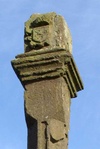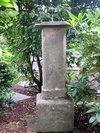| Crathes Castle, sundial, heraldic panels, weather vanes, doocot etc |
|---|

Crathes is particularly known for its ceiling paintings. Photography is not allowed in the castle but there are excellent photographs in the RCAHMS "canmore" database see: http://canmore.rcahms.gov.uk/en/site/36693/digital_images/crathes+castle/ . |
| Fettercairn Mercat Cross |

Fettercairn will have had some kind of market cross since 1504 when the status of a free burgh of barony was first granted. It is is said by some that the shaft of the current cross originally stood in the burgh of Kincardine which declined and eventually ceased when the judicial headquarters of the county moved to Stonehaven in 1600. There is no historical record of the cross being moved in this manner. |
| Flower-pot men |

An installation of figures made from wood and flower-pots beside a ready made? sundial. More Information |
| Harbour/Tolbooth Sundial |

Dated 1710. Free standing sundial. Cubic sandstone head with chamfered angles; horizontal dial with wrought-iron gnomon. Short, square-section shaft, also with chamfered angles, off-set below More Information |
| Mural Sundial |

Angle mural sundial and date stone enscribed "George Massie, Elspet Morrison 1739 Gods Providence is ourInheritance." More Information |
| Pithie memorial sundial |

A sandstone sundial on a square section pillar with chamfered corners mounted on cuboid pedestal. There are words carved around the edge that indicate it is a memorial to '??thie born 8th June 1836'. Below there are words but they are not readable On the back there is 'A Pithie' then 'born', the next bit has gone but the year seems to be 1812. The base is inscribed "W. Pithie mason 1857" More Information |
| Sundial Castle Fraser |

17th-century sundial with complex lectern dial in freestone More Information |
This content was submitted by external contributors and does not necessarily reflect the views of the University of Aberdeen.
